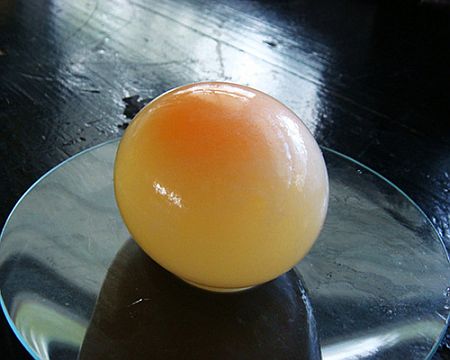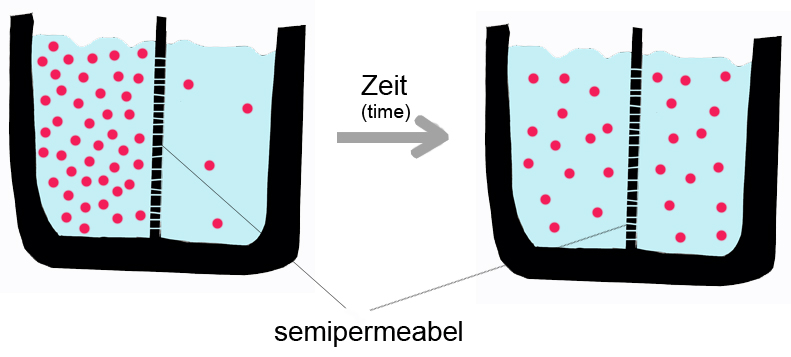Experiment 2: Diffusion in liquids
This experiment was to show how diffusion worked, that particles move from a higher region of concentration to a lower region of concentration. I set up three glass bowls of water- in the first bowl, the water was cold. In the second bowl, the water was room temperature, and in the third bowl, the water was hot. I dropped a drop of blue food colouring into all three bowls and compared how fast the food colouring in the water diffused. In the first bowl, the food colouring diffused the slowest. This is because the cold temperature slowed down the speed of the randomly moving particles, hence causing the particles to diffuse the slowest. In the second bowl, the food colouring diffused at a moderate speed. The particles moved faster than the particles in the first bowl, but moved slower than the particles in the third bowl, hence its moderate speed. In the third bowl, the food colouring diffused the fastest. This is because the high temperature increased the speed of the randomly moving particles, hence causing the particles to diffuse the fastest.
Here are some photos in the experiment.
At the start of the experiment-
After some time in the experiment-
Science Performance Task 2011
Thursday, February 3, 2011
Some experiments to help you understand better... (part 1)
Experiment 1: Osmosis- Potato slices in water
This experiment was to show how osmosis worked, that water particles move from a region of higher water concentration to a region of lower water concentration through a partially permeable membrane. I set up three glass bowls of water which were all at room temperature- the first bowl had no salt at all, the second bowl had one spoonful of salt, and the third bowl had two teaspoons of salt, and I put one potato strip measuring 3cm by 1cm by 1cm into each bowl. After 20 minutes, the potato strip in the first bowl measured 3.2cm by 1cm by 1cm, the potato strip in the second bowl still measured 3cm by 1cm by 1cm, and the potato strip in the third bowl measured 2.8cm by 1cm by 1cm. This is all a result of the process of osmosis. In the first bowl, there was a higher water potential outside the potato strip than inside the potato strip, hence the water in the bowl moved into the potato strip by osmosis, causing the potato strip to increase in length. In the second bowl, there was about the same number of molecules outside the potato strip and inside the potato strip, hence there was no noticeable difference in the length of the potato strip after the experiment. In the third bowl, there was a higher water potential inside the potato strip than outside the potato strip, hence the water from inside the potato strip moved out into the bowl by osmosis, causing the potato strip to decrease in length.
Here is a photo from the experiment:
This experiment was to show how osmosis worked, that water particles move from a region of higher water concentration to a region of lower water concentration through a partially permeable membrane. I set up three glass bowls of water which were all at room temperature- the first bowl had no salt at all, the second bowl had one spoonful of salt, and the third bowl had two teaspoons of salt, and I put one potato strip measuring 3cm by 1cm by 1cm into each bowl. After 20 minutes, the potato strip in the first bowl measured 3.2cm by 1cm by 1cm, the potato strip in the second bowl still measured 3cm by 1cm by 1cm, and the potato strip in the third bowl measured 2.8cm by 1cm by 1cm. This is all a result of the process of osmosis. In the first bowl, there was a higher water potential outside the potato strip than inside the potato strip, hence the water in the bowl moved into the potato strip by osmosis, causing the potato strip to increase in length. In the second bowl, there was about the same number of molecules outside the potato strip and inside the potato strip, hence there was no noticeable difference in the length of the potato strip after the experiment. In the third bowl, there was a higher water potential inside the potato strip than outside the potato strip, hence the water from inside the potato strip moved out into the bowl by osmosis, causing the potato strip to decrease in length.
Here is a photo from the experiment:
Tuesday, February 1, 2011
some diagrams and pictures about diffusion which would help you understand better
the above was taken from:
http://upload.wikimedia.org/wikipedia/commons/a/ac/Diffusion.jpg
 the above was taken from:
the above was taken from:
http://www.bio.miami.edu/~cmallery/150/memb/c8.7x11.diffusion.jpg
the above was taken from:
http://dickinsonn.ism-online.org/files/2009/11/626px-Scheme_simple_diffusion_in_cell_membrane-en_svg.png
http://upload.wikimedia.org/wikipedia/commons/a/ac/Diffusion.jpg

http://www.bio.miami.edu/~cmallery/150/memb/c8.7x11.diffusion.jpg
the above was taken from:
http://dickinsonn.ism-online.org/files/2009/11/626px-Scheme_simple_diffusion_in_cell_membrane-en_svg.png
Sunday, January 30, 2011
Difference between Osmosis and Diffusion
Diffusion is the movement of particles from an area of high concentration to an area of low concentration, while osmosis is the net movement of water molecules from an area of high concentration to a region of low concentration, through a partially permeable membrane.
Diffusion usually occurs in the gaseous state and the liquid state. It rarely happens in the solid state, but that does not mean that it would not happen at all. Furthermore, diffusion does not require water for the molecules to move.
On the other hand, osmosis requires water and usually happens with cells.When the liquid around the cell has a higher water concentration compared to the cell, the cell will gain water. This shows that osmosis requires water.
Defination of diffusion
Diffusion is a form of passive transport and it is the movement of molecules from a region of higher concentration to a region of lower concentration until both sides have an equal concentration.
Saturday, January 29, 2011
A conversation to help you understand better...
This is a conversation between a mother, her daughter and her son, based on our local slang, Singlish. We hope it will help you to understand the concept of diffusion and osmosis better, especially if you are familiar with this slang :) Enjoy!
Mother: So… what did you two learn in school today?
Sister: well, in science we learnt about diffusion.
Brother: What is deefeesion?
Sister: Its diffusion.
*brother farts*
Sister: Ew, what’s that horrible smell?
Brother: what smell? I don’t smell anything…
Sister: you farted right?
Brother: Huh. Like real lah. You anyhow accuse one. What is this?!
Sister: Okay lor… Hey! This is a perfect example of diffusion.
Mother: You’re right.
Brother: Can you tell me more about deefeesion?
Mother: Diffusion is the movement of particles from an area of high concentration to an area of low concentration. This works because everything is made up of very tiny particles. These particles are always moving and colliding with each other in the air as they move randomly. This is what causes diffusion. For example, when I cook dinner at home, you can smell my cooking from your room. This is because the smell is carried by particles that move around in the air from my food to your nose. When you farted just now, jie could smell it because the smell from your fart diffused in the air and travelled to her nose.
Brother: chey………
Sister: oh yeah hor! My teacher also talked about some other thing… Like got random particles from high dontknowwhat region to low also don’tknowwhat region! And the irritating thing is that it ISN’T diffusion! So confusing lah! What is it?
Mother: Oh and another thing that’s related to this is the process called osmosis! It’s *gets rudely interrupted*
Sister: CHEY! It’s osmosis sia! I remember now!
Mother: you prawn ah? Anyway, as I was saying before I was so rudely interrupted, osmosis is the process where water molecules move from a region of higher concentration to a region of lower concentration through a semi-permeable membrane. This usually occurs in cells. See this plant here?
*gestures at a plant*
Mother: when it photosynthesizes, water enters the plant cells by osmosis.
Sister: okay. Now I understand. Thanks mummy! Ohhhh I’m hungry, I smell food.
Brother: HAH. DIFEESEEEOONNNNN!! (:
Osmosis shown with a raw egg put in vinegar then in water
Video of osmosis shown in a Raw egg taken from:
Raw egg after being put in Vinegar:

Taken From: k/S5HRny0XSJI/AAAAAAAAA4Y/p9noQ5PGkZM/s400/IMG_6650.JPG
Raw Egg after being put in the water:

Taken From: http://vcebiology.edublogs.org/files/2010/02/egg-with-shell-removed1.jpg
Raw egg after being put in Vinegar:
Taken From: k/S5HRny0XSJI/AAAAAAAAA4Y/p9noQ5PGkZM/s400/IMG_6650.JPG
Raw Egg after being put in the water:

Taken From: http://vcebiology.edublogs.org/files/2010/02/egg-with-shell-removed1.jpg
Video on Osmosis (1)
Picture above taken from: http://dfmw.files.wordpress.com/2010/11/osmosis3.gif
Video taken from: http://www.youtube.com/watch?v=sdiJtDRJQEc
Definition of Osmosis
Osmosis is the net movement of water molecules from a region of higher water potential to a region of lower water potential through a partially permeable membrane.
Subscribe to:
Posts (Atom)






